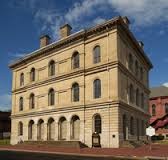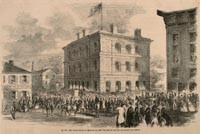Wheeling Custom House/West Virginia Independence Hall
Introduction
Text-to-speech Audio
Images
West Virginia Independence Hall today/

Photograph taken around 1870.
Custom House, Wheeling Frank Leslie's Illustrated Newspaper, August 10, 1861

Backstory and Context
Text-to-speech Audio
The Wheeling Custom House opened in 1859, and is one of the oldest structures still standing with large rolled wrought iron sections in it's framing. The developers used an wrought iron frame as opposed to wood, because of the many devastating fires that had previously happened in larger cities. Supervising Architect of the U.S. Treasury from 1852 to 1865, Ammi B. Young, designed the Wheeling Custom House under Captain Alexander H. Bowman from the U.S. Department of Treasury. Young's design was so solid, that there have been no major changes, except for the roof, since 1861.
Wheeling was named as a port of entry in 1831, and became a bustling industry town. This resulted in the B&O Railroad laying track through Wheeling in 1852 . The city became a critical transportation center with the National Road, and had the first bridge across the Ohio River, the Wheeling Suspension Bridge. These industries called for the need of federal buildings in the city of Wheeling, and the custom house doubled as a post office. However, the Wheeling Custom House became nationally significant during the Civil War era when it housed the the pro-Union state conventions of Virginia in the spring and summer of 1861, the capitol of loyal Virginia from June 1861 until June 1863, and the site of the first constitutional convention for West Virginia from November 1861 to February 1862, and the recalled session of the convention in February 1863.
"Its completion, coinciding with the beginning of the Civil War, provided a facility for heated political discussions and constitutional conventions that led to eventual statehood for West Virginia in 1863. Here, issues dividing many Virginians - slavery being one of many - were debated, compromised and shaped into the skeleton of statehood."1
Sectionalism between the eastern and western parts of Virginia started long before the Civil War era, and calls for secession started in the late 1820s at the constitutional convention of 1829-1830 in Richmond, VA due to white male suffrage and misrepresentation in the General Assembly. This issue of slavery became a prominent issue following Nat Turner's rebellion in 1831. Some abolitionists wanted to end slavery because of moral issues, but the majority of western Virginia abolitionists wanted to capitalize and profit by turning slaves' work into paying jobs for white males. During the constitutional convention of 1850 to 1851, held in Richmond, all white males over the age of twenty-one were given the right to vote regardless of whether they owned property, and approved the election of the governor and judges by the people. Delegates during this convention also agreed to a provision that allowed property to be taxed at its total value, except for slaves, who were to be valued at rates well below their actual worth.
Abraham Lincoln won the presidential election of 1860 without support from the South, which kick-started the southern states seceding from the Union.
"It is our duty on an occasion like this to elevate ourselves into an atmosphere, in which party passion and prejudice cannot exist - to conduct all our deliberations with calmness and wisdom, and to maintain, with inflexible firmness, whatever position we may find it necessary to assume." - John Janney of Loudoun County at the Virginia General Assembly of 1861.2
The majority of delegates representing the state of Virginia opposed secession until President Lincoln issued a call for 75,000 troops to put down the rebellion of Confederates following the surrender of Fort Sumter in 1861. In a vote of 88 to 55, Virginia left the Union with their Ordinance of Secession. Representative from the western part of Virginia immediately started their plan to seceded from Virginia.
On May 13, 1861, delegates representing twenty-seven western Virginia counties assembled here to plan their secession from Confederate Virginia at the First Wheeling Convention.
"Let us act, let us repudiate these monstrous usurpations; let us show our loyalty to Virginia and the Union; and let us maintain ourselves in the Union at every hazard. It is useless to cry peace when there is no peace; and I for one will repeat what was said by one of Virginia's noblest sons and greatest statesmen, 'Give me liberty or give me death!'" - John Carlile at the First Wheeling Convention.3
The delegates from the First Wheeling Convention successfully completed an Ordinance of Secession from Virginia in two days, and were ready to present to the public. This led to the Second Wheeling Convention, which began on June 11th, 1861.
"In this Convention we have no ordinary political gathering. We have no ordinary task before us. We come here to carry out and execute, and it may be, to institute a government for ourselves. We are determined to live under a State Government in the United States of America and under the Constitution of the United States. It requires stout hearts to execute this purpose; it requires men of courage - of unfaltering determination; and I believe, in the gentlemen who compose this Convention, we have the stout hearts and the men who are determined in this purpose." - Arthur Boreman, President of the Second Wheeling Convention.4
On June 20, the delegates selected officials to fill the offices of the Restored Government of Virginia. The first session of the Second Wheeling Convention ended on June 25th, and was to be adjourned on August 6th. However, the newly appointed governor, Francis Pierpont called for a meeting of the General Assembly of the Reorganized Government of Virginia on July 1st where he explained that President Lincoln pledged "full protection" to the people of western Virginia, and opposed any tax increases and requested that the Board of Public Works be abolished. The Reorganized Government of Virginia's legislature proposed, opposed, and approved various new legislatures and bills during this convention.
The second session of the Second Wheeling Convention began on August 6th, where legislatures finalized details of their Ordinance of Secession. The new state was to be named Kanawha, and would consist of 39 counties. On October 24, 1861, voters from the 39 counties of the proposed state of Kanawha voted to to determine the fate of the new state. This crucial event only churned out 34% of voters, with the results being 18,408 in favor of the new state, and 781 opposed.
The West Virginia Constitutional Convention met on November 26, 1861 to determine a name for the proposed state, boundaries, the issue of being a free state, and the issue of a township system. The new constitution was approved in a unanimous vote by the delegates on February 18, 1862, and the citizens approved the constitution 18,862 to 514. Even though they had the votes, West Virginia statehood leaders had to obtain permission from Virginia in order to satisfy the constitutional restriction. The creation of the Reorganized Government of Virginia allowed them to seek consent from this pro-Union body instead of the Confederate Virginia government in Richmond, and was granted permission.
With the permission to continue the journey to statehood, Senator Waitman T. Willey presented a formal petition to the United States Senate for the admission of West Virginia to the Union on May 29, 1862. The issue of slavery was the only thing separating West Virginia from officially becoming a state. A compromise was made with the Willey Amendment, which called for the gradual emancipation of slavery. On July 14, 1862, both the Willey Amendment and the West Virginia statehood bill passed by a vote of 23 to 17. There were heated debates in the House of Representatives, but on December 10, 1862, the House passed the statehood bill by a vote of 96 to 55. Now the only missing link was the approval from President Lincoln. After much debate between Lincoln and his advisers, he approved the new state of West Virginia because he could not afford to lose the Union support.
"Doubtless those in remaining Virginia would return to the Union, so to speak, less reluctantly without the division of the old state than with it; but I think we could not save as much in this quarter by rejecting the new state, as we should lose by it in West Virginia. We can scarcely dispense with the aid of West Virginia in this struggle; much less can we afford to have her against us, in Congress and in the field. Her brave and good men regard her admission into the Union as a matter of life and death. They have been true to the Union under very severe trials. We have so acted as to justify their hopes; and we can not fully retain their confidence, and co-operation, if we seem to break faith with them." - Abraham Lincoln.5
On June 20, 1863, West Virginia became the thirty-fifth state in the Union with Arthur Boreman as it's first governor.
Sources
1. “East Vs. West.” Accessed October 21, 2016. http://www.wvculture.org/history/statehood/statehood01.html. 2. “Richmond Convention.” Accessed October 21, 2016. http://www.wvculture.org/history/statehood/statehood03.html. 3. “First Wheeling Convention.” Accessed October 21, 2016. http://www.wvculture.org/history/statehood/statehood05.html. 4. “First Session of the Second Wheeling Convention.” Accessed October 21, 2016. http://www.wvculture.org/history/statehood/statehood07.html. 5. “Lincoln’s Dilemma.” Accessed October 21, 2016. http://www.wvculture.org/history/statehood/statehood14.html. 6. “National Register of Historical Places Nomination Form.” Accessed October 21, 2016. http://www.wvculture.org/sites/nominations/70000660.pdf.
